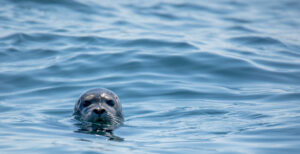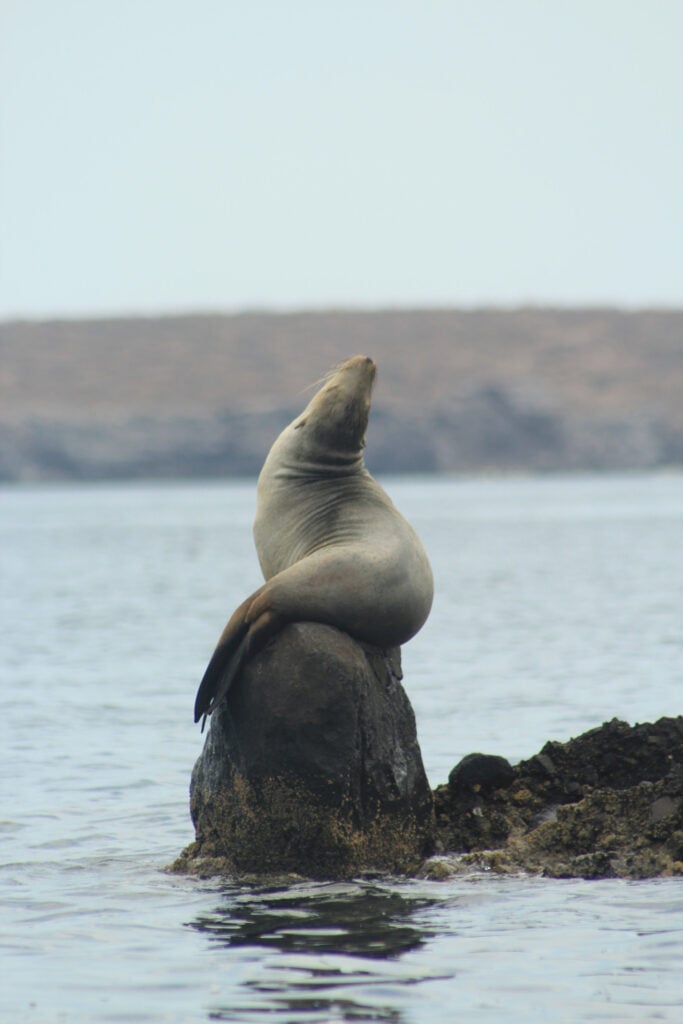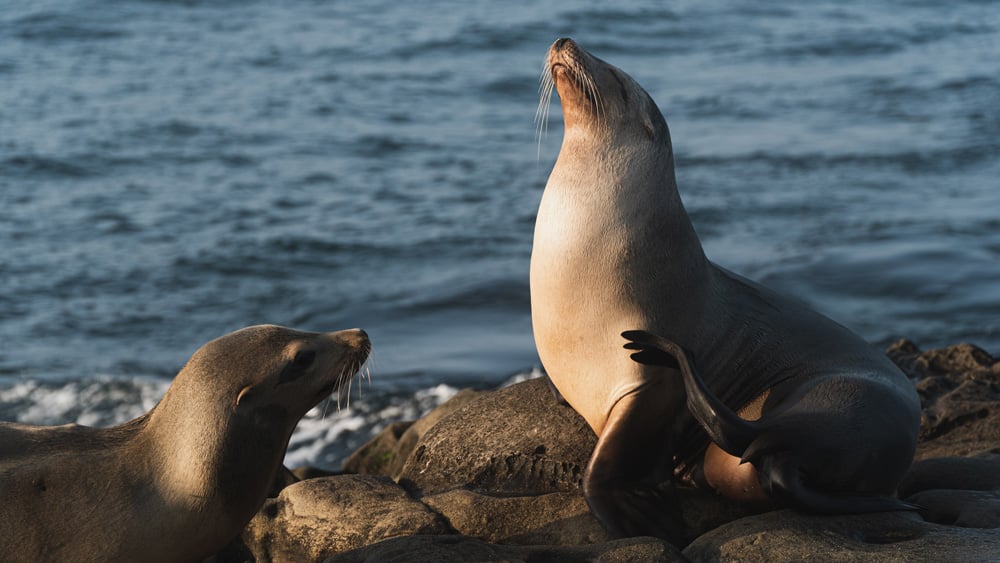Featured in this Post
Keep Exploring
San Diego, California
Essential San Diego
Learn More
San Diego is famous for its seal and sea lion colonies—from sunning themselves on sandy beaches to swimming out in the ocean, it’s pretty much impossible to visit this Southern California city and not see these seagoing creatures. Here’s everything you need to know about San Diego’s sea lions and seals.
How San Diego became a seal and sea lion hotspot
 In the early 1990s, the local harbor-seal population was increasing, and more and more seals and sea lions were spotted in the San Diego area. A Marine Mammal Reserve was created to protect them, and the colonies flourished.
In the early 1990s, the local harbor-seal population was increasing, and more and more seals and sea lions were spotted in the San Diego area. A Marine Mammal Reserve was created to protect them, and the colonies flourished.
Why San Diego? San Diego offers a mild climate with relatively consistent temperatures year-round, which is perfect for sea lions. The coastal geography provides numerous beaches, rocky shores, and sheltered coves that are ideal for sea lions to haul out, rest, and bask in the sun.
The waters around San Diego are rich in marine life, providing a plentiful food supply. Sea lions feed on a variety of fish, squid, and other marine organisms that thrive in the region. The coastal upwelling in the area brings nutrient-rich waters to the surface, supporting a productive food web that sea lions rely on.
But over the years, there’s been much debate as to whether humans or pinnipeds have more right to La Jolla’s beaches. The seawall-protected Children’s Pool has been the focal point of these arguments, as some citizens want the beach to go back to being humans-only. On the other side, animal-rights advocates argue for stronger protections for seals and sea lions alike.
The high amounts of waste have also been a health concern, and because of the strong smell, some businesses want the colonies relocated elsewhere. Long story short: Though many visitors and locals love viewing and visiting sea lions and seals, not everyone is happy about their presence. San Diego does have several protected areas and marine reserves, offering safe environments for sea lions to rest and raise their pups without significant human disturbance.
What’s the difference between a seal and a sea lion?
The beaches and coves of San Diego are home to both the Pacific Harbor seal and the California sea lion. But when you’re watching one of them flop onto the beach or doze in the sun, how do you know if it’s a seal or sea lion?
While these marine mammals are both pinnipeds, there are key differences. Seals are smaller than sea lions and don’t have external ear flaps; sea lions are bigger, with ear flaps and larger flippers. Also, Pacific Harbor seals usually have spotted coats, while California sea lions’ tend to be dark brown.
What’s the best time of year to see sea lions and seals in San Diego?
Seals and sea lions live in San Diego year-round, so you’ll be able to spot them pretty much anytime.
You’ll have the best odds of seeing seals out on the beaches between late April and early June, but their birthing season is mid-December to mid-May—and that’s arguably the best time to visit. Though the birthing beaches may be closed off or have restricted access during this time, you can watch from a distance and maybe even see a live birth! (For newborn sea lion pups, on the other hand, aim for mid-May to mid-July.)

What are the best places to see San Diego’s sea lions and seals?
If you’re wondering where to see seals in San Diego, there are several locations to hit.
La Jolla Cove is the best place to find sea lions
Less than 20 miles north of downtown San Diego in the community of La Jolla, La Jolla Cove is the most famous place in the area to find sea lions. Scores of them lay out on this wide strip of sand encircled by rocky cliffs, and you can even walk on the beach nearby.
Children’s Pool Beach is the best place to see La Jolla seals
Guarded by a breakwater seawall, roughly 10 minutes from La Jolla Cove, this calm beach was originally created to be a safe swimming area for families and kids, just steps from downtown La Jolla.
But now, thanks to its peaceful waters and quiet beach, it’s where La Jolla seals prefer to give birth and nurse their young. If seeing seal pups is on your San Diego trip checklist, be sure to head to the Children’s Pool Beach seal rookery.
Where else can I see La Jolla sea lions and Seals?
Boomer Beach, the Seven Sea Caves of La Jolla, Shell Beach near Ellen Browning Scripps Park, and other areas of Seal Rock, where Children’s Pool is located, are great spots to spy seals and California sea lions frolicking or relaxing on the beach.

Responsible ways to view sea lions and seals in San Diego
San Diego sea lions and seals are wild animals protected by law, with hefty fines for disturbing them. But it’s possible to see and interact with them as long as you do so respectfully. At La Jolla Cove and Children’s Pool, you can stroll on the beach to take a closer look, or hit the La Jolla Coast Walk Trail for a more panoramic view.
When it comes to San Diego seal life tours, City Cruises has a Whale & Dolphin Adventure cruise offer the chance to see the marine mammals out on the open ocean.
You can even go snorkeling or scuba diving in the waters of the San Diego-La Jolla Underwater Park Ecological Reserve to view sea lions, seals, sea turtles, and more in their natural habitat, accompanied by a certified guide.
Tips for visiting seals and sea lions in the San Diego area
- While exploring La Jolla’s beaches, cliffs, and tide pools, wear close-toed shoes so you don’t slip.
- Be prepared: The smell of seal and sea-lion poop can be really strong, but seeing the adorable animals is worth it.
- Respect the laws surrounding seals and sea lions by not getting too close, not littering, and not feeding them. It’s for your safety and protection as well as theirs—and you can be fined if you don’t comply.
- Since the colonies are still threatened, you can donate to local organizations like the Seal Conservancy.
- If you see wild animals being harassed, abused, or hurt in any way, alert the San Diego Police Department or on-duty lifeguards.
- Check Tidal Conditions: Before your visit, check the tidal conditions as they can affect beach accessibility and the visibility of the animals.
- Use Binoculars for a Closer Look: Bring a pair of binoculars for a closer view of the seals and sea lions without disturbing them.
- Best Times for Viewing: Visit early in the morning or later in the afternoon for fewer crowds and more active wildlife.
- Photography Tips: If you’re planning to take photos, use a zoom lens to capture close-up shots while maintaining a respectful distance.
- Educational Resources: Take advantage of interpretive signs and information boards in the area to learn more about the local wildlife.
- Pack Sun Protection: The coastal areas can be sunny. Bring sunscreen,
San Diego’s seals and sea lions are so cute, you need to “sea” it to believe it
Heading to La Jolla to see the local seal and sea lions colonies is a classic must-do in San Diego and is a great chance to see these animals living their lives out in the wild. It also advocates for their continued protection.
FAQs – Seals in San Diego
What is the difference between seals and sea lions in San Diego?
Seals and sea lions, both pinnipeds, can be distinguished by size, ear flaps, and flipper size. Seals are smaller without external ear flaps, while sea lions are larger with visible ear flaps.
When is the best time to see seals and sea lions in San Diego?
Seals and sea lions are present year-round, but the best time to see seals is between late April and early June, and mid-May to mid-July for sea lion pups.
Where are the best spots to see seals and sea lions in San Diego in 2024?
La Jolla Cove and Children’s Pool Beach are prime locations for observing these marine animals, along with other areas like Boomer Beach and Seal Rock.
How can I responsibly view seals and sea lions in San Diego?
It’s important to view them from a respectful distance, adhere to local laws protecting them, and avoid disturbing them, especially during their birthing seasons.
Are guided tours available to see seals and sea lions?
Yes, guided tours are offered in areas like La Jolla, where you can learn more about the behavior and habitat of these marine animals.
Can I see seals and sea lions during a boat tour in San Diego?
Boat tours in San Diego often provide opportunities to see seals and sea lions in their natural habitat, along with other marine wildlife.
What should I bring when visiting seal and sea lion viewing spots?
It’s recommended to bring binoculars for a closer view, a camera for photos, and to dress in layers as the coastal areas can be cool and windy.
What Are the Behavioral Differences Between Seals and Sea Lions?
Seals are generally more solitary and less vocal, while sea lions are known for their sociability and frequent barking.
What Conservation Efforts Are in Place for Seals and Sea Lions in San Diego?
San Diego has implemented various initiatives and regulations to protect these marine mammals and their habitats, emphasizing sustainable interaction with wildlife.
Can Children Participate in Seal and Sea Lion Watching Activities?
Yes, many viewing spots and educational programs in San Diego are family-friendly and suitable for children, offering a fun and informative experience.
What Is the Impact of Human Interaction on Seals and Sea Lions?
Human activities can significantly affect the behavior and well-being of seals and sea lions, highlighting the need for responsible viewing practices.
Are There Specific Rules or Regulations for Interacting with Seals and Sea Lions in San Diego?
There are legal guidelines and best practices in place to ensure the safety and protection of these marine mammals during human interactions.
What Role Do Seals and Sea Lions Play in the Local Ecosystem?
Seals and sea lions are crucial for maintaining the balance in San Diego’s marine ecosystem, contributing to biodiversity and ecological health.
How Do Seasonal Changes Affect Seal and Sea Lion Populations?
Seasonal variations impact the behavior, diet, and migration patterns of seals and sea lions, influencing where and how they can be observed.
Can I Volunteer or Support Local Seal and Sea Lion Conservation Efforts?
Opportunities for volunteering and supporting conservation efforts are available in San Diego, allowing individuals to contribute to the well-being of these species.
What Are the Common Challenges Faced by Seals and Sea Lions in San Diego?
Environmental changes and human-related activities pose challenges to the health and survival of seals and sea lions in the region.
How Has the Seal and Sea Lion Population in San Diego Changed Over Time?
The seal and sea lion populations have undergone various changes over time, with current efforts focusing on monitoring and conserving these vital marine communities.
Original Publish Date: July 21, 2022
Featured in this Post
Keep Exploring
San Diego, California
Essential San Diego
Learn More


